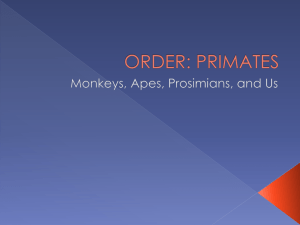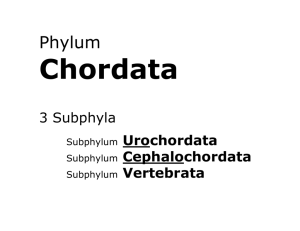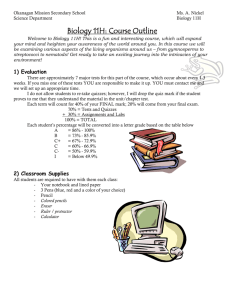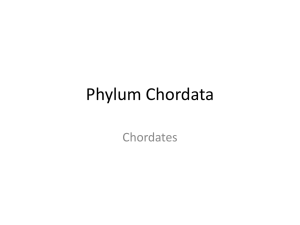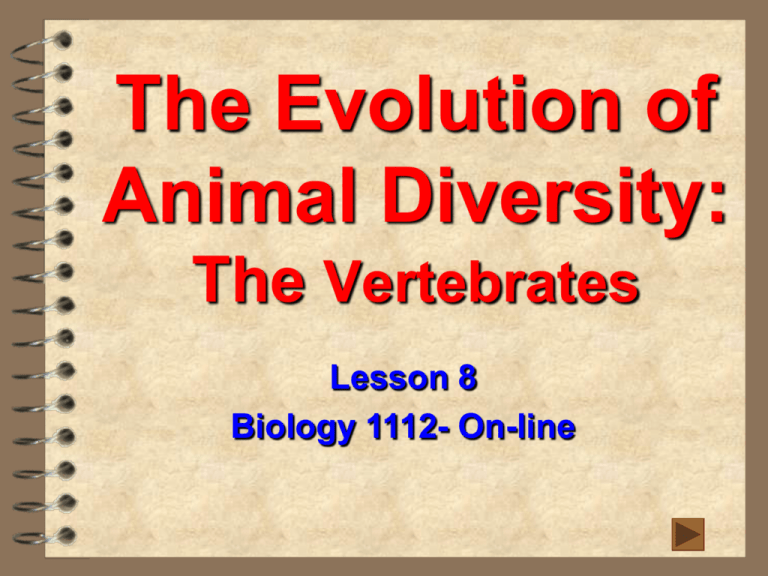
The Evolution of
Animal Diversity:
The Vertebrates
Lesson 8
Biology 1112- On-line
Characteristics of Chordates
Four features are evident in chordate
embryos and some of these may persist
into adulthood
– Dorsal, hollow nerve cord
– Notochord - a long support rod in the body
of the vertebrate that is NOT composed of
cartilage or bone
– Gill slits in pharynx
– Post-anal tail
3/16/2002
Biology 1112 – Lesson 8
© All Rights Reserved 2002
2
Chordate Classification
• Phylum – Chordata
– Invertebrate chordates
• Tunicates
• Lancelets
–Vertebrata
• These have a real back bone
3/16/2002
Biology 1112 – Lesson 8
© All Rights Reserved 2002
3
Invertebrate
Chordates
Chordates WITHOUT
Backbones
Tunicates
A free-swimming tunicate larva (a) and an adult tunicate (b). In the
larva, the body is stiffened by a notochord, there is a dorsal nerve
cord, and the tail extends beyond the anus. The only defining
chordate feature retained in the adult tunicate is the pharynx with gill
slits.
3/16/2002
Biology 1112 – Lesson 8
© All Rights Reserved 2002
5
Tunicates
Another diagram of a free-swimming tunicate larva. In
the larva, the body is stiffened by a notochord, there is a
dorsal nerve cord, and the tail extends beyond the anus.
3/16/2002
Biology 1112 – Lesson 8
© All Rights Reserved 2002
6
Lancelets
Body plan of an adult lancelet. Note the defining
chordate features: a notochord, a dorsal nerve cord, a
pharynx with gill slits, and a tail that extends beyond the
anus.
3/16/2002
Biology 1112 – Lesson 8
© All Rights Reserved 2002
7
Vertebrate Classification
There Are Seven Classes of Vertebrates
That Have Living Representatives.
–
–
–
–
–
–
–
3/16/2002
Agnatha - jawless fishes
Chondrichthyes - cartilaginous fishes
Osteichthyes - bony fishes
Amphibia - Amphibians (frogs, salamanders)
Reptilia - Reptiles (snakes, turtles)
Aves - birds
Mammalia - mammals
Biology 1112 – Lesson 8
© All Rights Reserved 2002
8
Existing Jawless
Fishes
Phylum - Chordata Subphylum -Vertebrata
Class - Agnatha
Jawless fishes (class
Agnatha). Hagfishes prey
on worms and scavenge.
They lack jaws but have a
rasping tongue.
Lampreys are specialized
parasite-like predators.
They latch onto prey with
an oral disk and use
horny, toothlike parts to
grasp their victims' flesh.
3/16/2002
Biology 1112 – Lesson 8
© All Rights Reserved 2002
10
Existing Jawed
Fishes
Phylum Chordata - Subphylum Vertebrata
Class - Chondrichthyes
Representative cartilaginous fishes (class Chondrichthyes). Sharks
prey on marine invertebrates, fishes, and mammals. Skates, rays,
and chimaeras patrol the sea bottoms, searching for hard-shelled
prey. Chimaeras are commonly called ratfishes.
3/16/2002
Biology 1112 – Lesson 8
© All Rights Reserved 2002
12
Phylum Chordata - Subphylum Vertebrata
Class - Osteichthyes
The typical teleost body plan and anatomy, represented here by a
perch. The swim bladder is an adjustable flotation device that allows
the fish to regulate its buoyancy. In all fishes, the heart has two
chambers—an atrium and a ventricle.
3/16/2002
Biology 1112 – Lesson 8
© All Rights Reserved 2002
13
Amphibians
Phylum Chordata - Subphylum Vertebrata
Class - Amphibia
Two salamanders (amphibian order Caudata). Most salamanders
live in the Northern hemisphere. They are carnivorous, preying
on small arthropods, worms, and mollusks.
3/16/2002
Biology 1112 – Lesson 8
© All Rights Reserved 2002
15
Phylum Chordata - Subphylum Vertebrata
Class - Amphibia
A frog and a toad. Both are members of the amphibian
order Anura, which means "without a tail." Some are
aquatic, some are terrestrial, and some live in trees. The
adults are air-breathing carnivores.
3/16/2002
Biology 1112 – Lesson 8
© All Rights Reserved 2002
16
Reptiles
Phylum Chordata - Subphylum Vertebrata
Class - Reptilia
A rattlesnake and a frilled lizard, both in defensive
postures. Snakes arose from short-legged, long-bodied
lizards. All snakes have highly movable jaws. Some, like
this rattlesnake, produce poisonous venom.
3/16/2002
Biology 1112 – Lesson 8
© All Rights Reserved 2002
18
Phylum Chordata - Subphylum Vertebrata
Class - Reptilia
A Galápagos tortoise and a green sea turtle. All sea
turtles are in danger of extinction. The turtles are
threatened by human development of beach habitat and
by poaching.
3/16/2002
Biology 1112 – Lesson 8
© All Rights Reserved 2002
19
Phylum Chordata - Subphylum Vertebrata
Class - Reptilia
Body plan of a male crocodile. A reptile’s brain is small compared
to the rest of its body mass, but it governs complex forms of
behavior unknown among amphibians. The cerebral cortex, the
most complex part of the forebrain, evolved first among the reptiles.
3/16/2002
Biology 1112 – Lesson 8
© All Rights Reserved 2002
20
Birds
Phylum Chordata - Subphylum Vertebrata
Class - Aves
Birds range in size from tiny hummingbirds weighing as little as 2.25
grams (0.08 ounce) to ostriches weighing about 150 kilograms (330
pounds). Ostriches cannot fly, but they are excellent sprinters.
3/16/2002
Biology 1112 – Lesson 8
© All Rights Reserved 2002
22
Phylum Chordata - Subphylum Vertebrata
Class - Aves
Like reptiles, birds lay amniote eggs. However, birds invest far
more energy than reptiles in the care of their eggs. Just about all
birds build nests and incubate their eggs. The structure of a bird's
egg is shown above.
3/16/2002
Biology 1112 – Lesson 8
© All Rights Reserved 2002
23
Phylum Chordata - Subphylum Vertebrata
Class - Aves
An artist’s reconstruction
based on a 150 million-yearold fossil of an extinct bird –
Archaeopteryx. Like
modern birds, it had wing
feathers but like reptiles it
had had wing claws, teeth,
and a tail composed of
vertebrae. Despite its
feathers, Archaeopteryx is
not considered an ancestor if
modern birds.
3/16/2002
Biology 1112 – Lesson 8
© All Rights Reserved 2002
24
Mammals
Phylum Chordata - Subphylum Vertebrata
Class - Mammalia
Of all the vertebrates, only female mammals feed their
young with milk, a nutritious fluid produced by the
mammary glands.
3/16/2002
Biology 1112 – Lesson 8
© All Rights Reserved 2002
26
Phylum Chordata - Subphylum Vertebrata
Class - Mammalia
Two distinctively mammalian characteristics are fur and specialized
dentition. Only mammals have hair or fur to help them conserve body
heat. Mammals have a distinctive arrangement of teeth. The teeth of the
upper and lower jaws match up, allowing mammals to cut and chew food
instead of simply swallowing it whole, as reptiles must. There are four
types of mammalian teeth:molars, premolars, canines, and incisors.
3/16/2002
Biology 1112 – Lesson 8
© All Rights Reserved 2002
27
Phylum Chordata - Subphylum Vertebrata
Class - Mammalia
Montremes - egg-laying mammals
3/16/2002
Biology 1112 – Lesson 8
© All Rights Reserved 2002
28
Phylum Chordata - Subphylum Vertebrata
Class – Mammalia
Marsupials - pouched mammals
3/16/2002
Biology 1112 – Lesson 8
© All Rights Reserved 2002
29
Phylum Chordata - Subphylum Vertebrata
Class - Mammalia
Eutherians - placental mammals
3/16/2002
Biology 1112 – Lesson 8
© All Rights Reserved 2002
30
Phylogenetic tree of the
Animal Kingdom
The phylogenetic
tree gives animal
diversity an
evolutionary
perspective.
3/16/2002
Biology 1112 – Lesson 8
© All Rights Reserved 2002
31
3/16/2002
Biology 1112 – Lesson 8
© All Rights Reserved 2002
32

